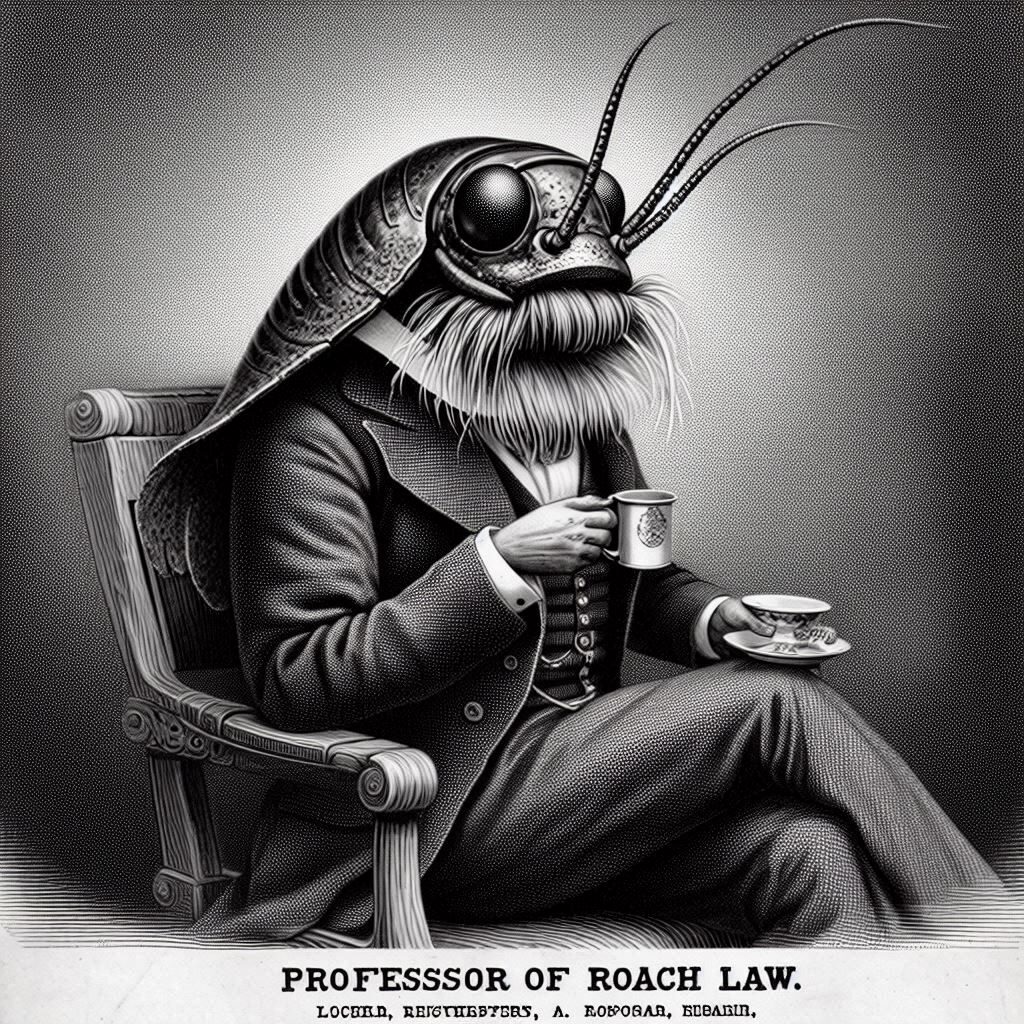
The concept of the “Way of the Roach and Cat” is shrouded in mystery and intrigue. Despite its obscure origins and unconventional medium of documentation, this enigmatic philosophy has captivated the curiosity of scholars and laypeople alike. This paper aims to unravel the complexities surrounding the Way of the Roach and Cat, exploring its historical context, the peculiar methods of its documentation, and the tragic events that led to its near-eradication. Central to this narrative is the figure of Randall Williams III Esquire, Professor of Roach Law, and his cryptic writings, which were ultimately lost in a catastrophic extermination event in Austin, Texas.
The Way of the Roach and Cat was first chronicled by Randall Williams III Esquire, a roach with an unusual capacity for writing. Utilizing his feces as a medium, Williams penned what is believed to be a comprehensive description of this unique philosophy. The writings were located in an apartment in Austin, Texas, the residence of Conrad Freeman, also known by his pseudonyms Daniel Kliewer and “Asshole” as referred to on the street.
The apartment served as a hub for the followers of Captain Edmeowd Snowden, a cat of significant renown and influence. According to Freeman, Captain was a figure of immense power and mystery, purportedly placed under his watch by the Russian government due to suspicions about the cat’s potential knowledge of national security secrets. Captain’s numerous followers, referred to derogatorily as roaches, were led by the learned Randall Williams III Esquire.
The documentation of the Way of the Roach and Cat through roach feces presents a unique challenge to historians and linguists. The writings were encoded in a form of script legible only to Freeman, who asserts that Williams’ ability to communicate through this medium was unparalleled among his peers. The use of feces as a writing tool is not entirely unprecedented in the animal kingdom, but its application in this context is singularly remarkable and suggests a level of cognitive sophistication in Williams.
Freeman describes his initial reaction to the writings as a journey from confusion to amazement. The texts, though crude in medium, reportedly contained profound insights and intricate philosophical tenets. Unfortunately, these writings were lost during a significant event known as the Great Extermination.
The Great Extermination refers to a mass extermination event carried out by the city of Austin, targeting the roach population in Freeman’s apartment. This catastrophic event resulted in the deaths of millions of roaches, including the followers of Captain Edmeowd Snowden. The extermination also led to the destruction of the original texts detailing the Way of the Roach and Cat, as malicious cleaners obliterated all traces of Williams’ writings.
Freeman attributes the origins of this tragedy to a seemingly trivial incident: his decision to go outside. This act set off a chain of events culminating in the eviction of Freeman from his apartment and the subsequent extermination operation. The loss of the texts represents not only a personal tragedy for Freeman but also a significant cultural and intellectual loss.
Captain Edmeowd Snowden, or Captain, is a central figure in this narrative. Described as a cat with unparalleled influence, Captain was allegedly under surveillance by Freeman due to his supposed connections to the National Security Agency and the Russian government. Captain’s interactions with his roach followers and his enigmatic presence contributed to the formation and dissemination of the Way of the Roach and Cat.
Freeman’s role was ostensibly that of a caretaker and observer, tasked with monitoring Captain and managing his numerous contacts. These contacts, the roaches, formed a community under the intellectual leadership of Randall Williams III Esquire. The dynamics between Captain, Freeman, and the roaches create a complex web of relationships pivotal to understanding the development and subsequent loss of the Way of the Roach and Cat.
Despite the obliteration of the primary texts, Freeman’s recollections provide a fragmented but invaluable account of the Way of the Roach and Cat. His narrative suggests a philosophy deeply intertwined with themes of survival, intelligence, and community. The use of feces as a medium reflects a resourcefulness and resilience characteristic of the roach community.
Moreover, the tragic end of this philosophical tradition underscores the vulnerabilities of subaltern narratives in the face of dominant societal forces. The extermination event highlights the precariousness of knowledge preservation and the often-overlooked impact of urban pest control measures on micro-communities.
The Way of the Roach and Cat remains an elusive and enigmatic philosophy, its teachings obscured by the unconventional methods of its documentation and the tragic events leading to its near-eradication. The figures of Randall Williams III Esquire and Captain Edmeowd Snowden occupy central roles in this narrative, symbolizing the intersection of intelligence, survival, and tragedy within the roach community.
Future research should aim to reconstruct the lost teachings through any surviving fragments and oral histories, thereby preserving this unique intellectual tradition. The story of the Way of the Roach and Cat serves as a poignant reminder of the diverse forms of knowledge and the fragility of cultural heritage in the face of extermination and displacement.
Leave a Reply